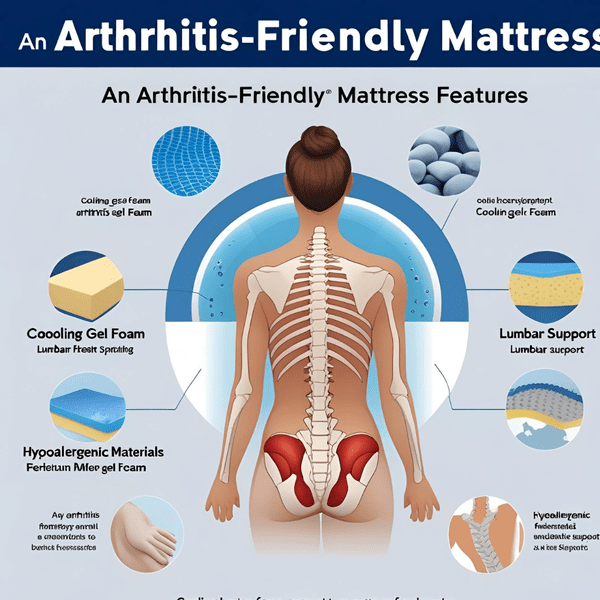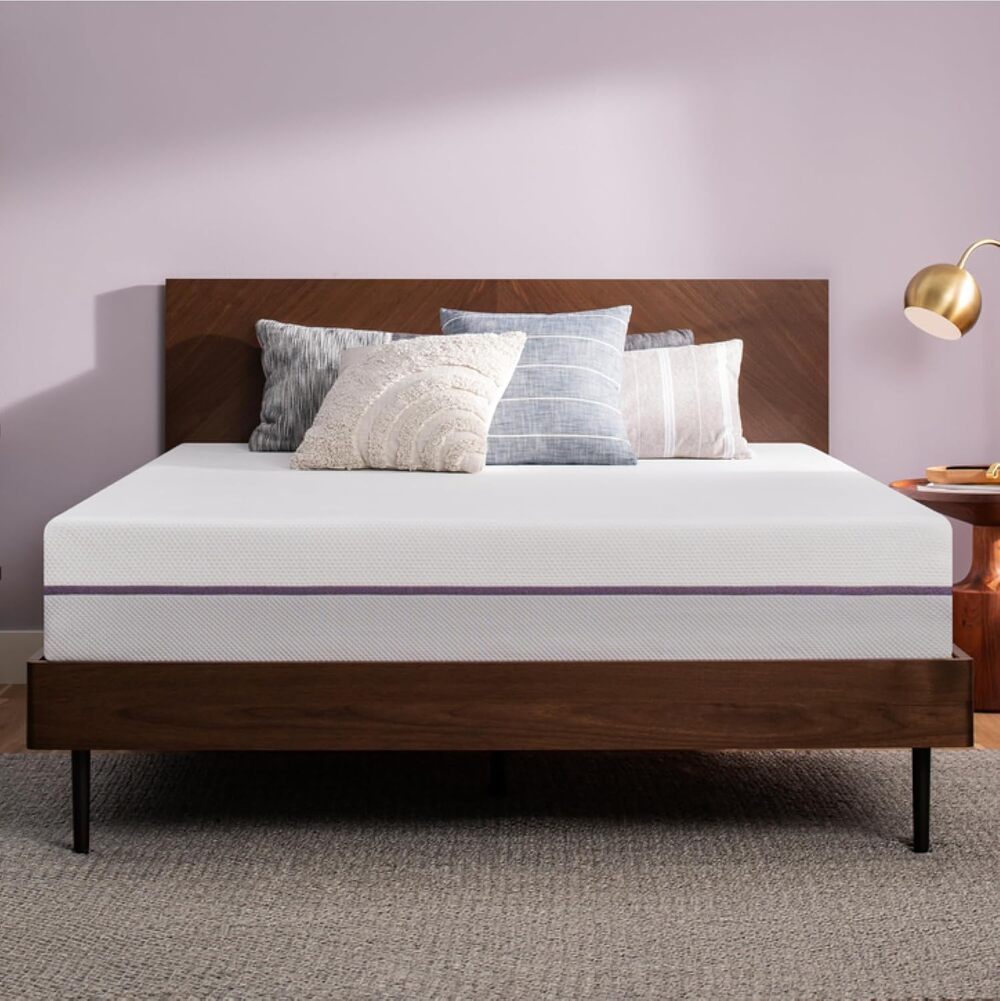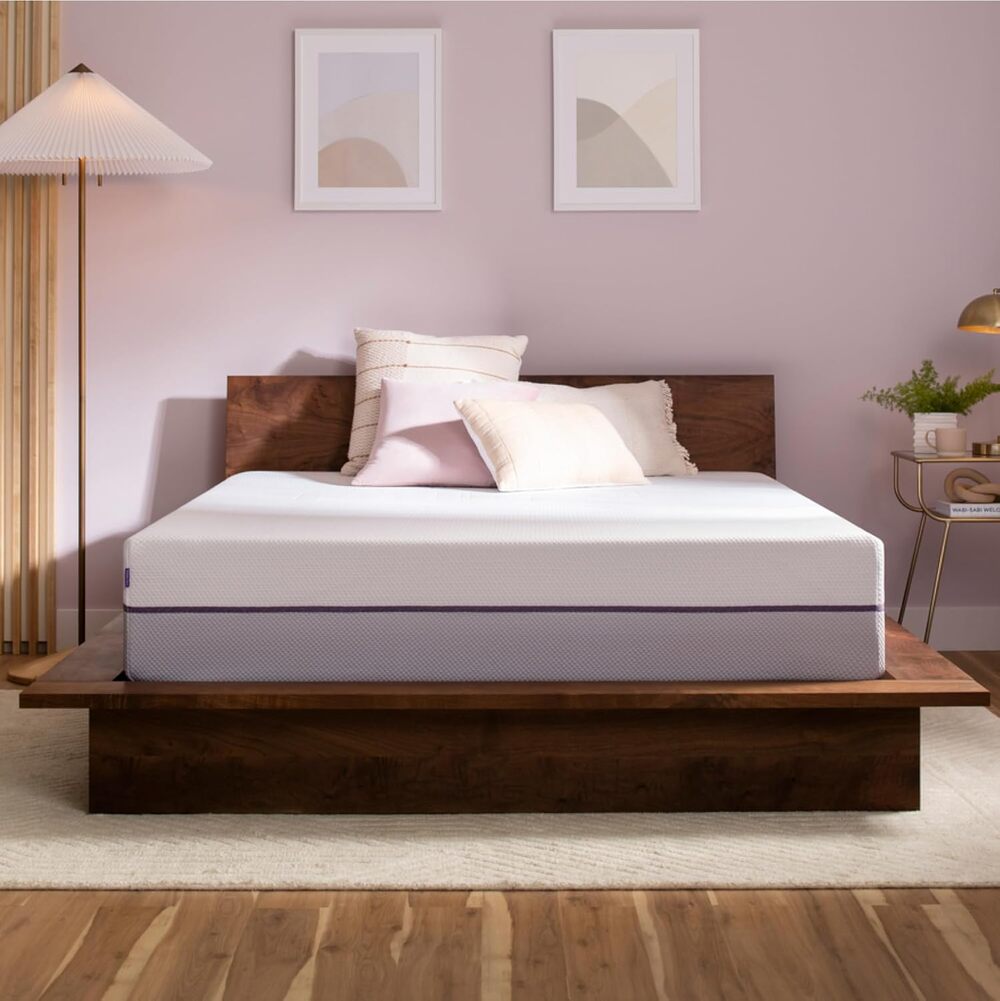How to Choose a Mattress for Rheumatoid Arthritis Support
Why Best mattress for rheumatoid arthritis matters? Imagine this: the alarm goes off at 6:30 a.m., and before your feet even touch the floor, your hands feel like they’ve spent the night clutching a block of ice. Your knees argue with every micro-movement, and your shoulders throb as if you’d spent eight hours doing push-ups instead of sleeping. If that scene feels painfully familiar, then keep in mind that you’re not alone. Roughly 1.3 million Americans live with rheumatoid arthritis, and for most of them, the first battle of the day is fought in bed—before the coffee, before the commute, before life even starts.

Here’s the kicker: the surface you sleep on can either be your silent ally or your loudest saboteur. That’s why finding the <strong> isn’t a luxury purchase; it’s daily self-care disguised as bedroom furniture. In the next few minutes, we’ll unpack exactly what RA does to nighttime comfort, how the wrong support layers can amplify inflammation, and—most importantly—what to look for when you’re shopping so you wake up with less stiffness, fewer hot spots, and a lot more “good-morning” in your step.
What RA Really Does to Your Sleep—Beyond the Obvious Aches
“RA flips your body’s defense system into a rogue attacker—mistaking the very lining that cushions your joints for an enemy. It’s like your immune system declares war on the peacekeeper, leaving joints vulnerable to the crossfire.“The result? Swelling today, stiffness tomorrow, and down the road—real damage to the joint itself.”
While medication can tame daytime flares, nighttime is a different beast. During deep sleep, inflammatory cytokines surge, causing joint swelling that presses against nerves and surrounding tissue. Add in the micro-awakenings that come from trying to roll over on a sagging surface, and you’ve got a recipe for 3 a.m. misery.
10:30 p.m. – Finally doze off after adjusting pillows for the fourth time.
12:15 a.m. – Shoulder pain jolts you awake; you flip to the other side.
2:40 a.m. – Hip pressure builds; you add a second pillow between knees.
5:05 a.m. – Ankles feel like they’re in a vise; you stare at the ceiling until sunrise.
Sound familiar? Often, the real problem isn’t just your condition—it’s your mattress working against you. When it doesn’t properly support spinal alignment or cushion pressure points, it amplifies pain rather than relieving it. When hips sink too far, the lumbar arch collapses, tugging on already-inflamed facet joints. When shoulders ride too high, the rotator cuff can’t relax, and morning stiffness skyrockets. A surface that “feels soft” in the showroom can morph into a torture device by midnight if it lacks adaptive support.
A common myth we hear in RA support groups is, “If it hurts, buy the firmest mattress you can find.” Truth is, rock-hard mattresses don’t equal better support. They just trade one problem for another, leaving you with new pressure points—imagine sleeping on hardwood versus sinking into therapeutic foam.
The Three Silent Saboteurs of RA Rest
1. Heat Retention
Inflammation already elevates core temperature. A mattress that traps warmth can trigger sweating, prompting midnight repositioning that jars tender joints. Prioritize breathable covers, gel-infused or open-cell foams, and coil systems that allow air to move.
2. Motion Ripple
If another body is in the bed, every subtle shift creates mini-earthquakes. Individually wrapped coils and dense comfort layers isolate movement so one person’s rollover doesn’t become the other’s flare trigger.
3. Edge Breakdown
Your bed should launch you into the day, not trap you in a cozy vortex. If mornings start with a struggle, your mattress failed its one job. Engineered with reinforced borders to provide stable sitting support, reducing strain on wrists and hips by maintaining proper alignment.
A Real-Life Win: How Mark Reclaimed His Mornings
Mark, a 50-year-old high-school teacher from Milwaukee, kept a nightly log for eight weeks. On his aging innerspring set, morning stiffness averaged 8/10 and required 30 minutes of hot-shower therapy.
During a stay at a boutique lodge, he slept on a pocketed-coil hybrid with a breathable latex top. The next morning, he rated stiffness at 3/10 and skipped the shower routine entirely. Armed with that firsthand data, he replaced his home setup with a zoned hybrid featuring gel-infused memory foam. Two weeks later, his average morning score hovered at 4/10, and he was able to walk the dog before breakfast instead of after Advil. No miracle cure—just smarter engineering under his spine.
Your Next Move: From Battleground to Recovery Zone
The path to better sleep isn’t about chasing trends—it’s about finding what truly works for your body. The secret? pressure relief to ease aches, smart support that adjusts, cooling comfort that lasts, and motion isolation that sticks. Master these, and you master sleep itself.When you do, those eight hours in bed become more than just downtime—they transform into real, restorative recovery.
Next, we’ll dive into the key mattress types—hybrid, all-foam, latex, and adjustable air—helping you find the perfect match. Because the right bed doesn’t just help you sleep… it ensures you wake up refreshed, not dreading the day ahead.
Comparison Table:
| Feature | Purple 9.25″ Original | Purple Plus 11″ | TEMPUR-LuxeAdapt 2.0 13″ Hybrid |
|---|---|---|---|
| CHECK PRICE | CHECK PRICE (on Amazon) | CHECK PRICE (on Amazon) | CHECK PRICE (on Amazon) |
| Price Tier | Mid | Mid-Plus | Premium |
| Overall Height | 9.25″ | 11″ | 13″ |
| Top Comfort Layer | 2″ GelFlex Grid | 2″ GelFlex Grid + 1″ Premium Foam | 2″ TEMPUR-ES™ Memory Foam |
| Support Core | 7″ High-Density Foam | 7″ Responsive Foam | 1,000+ Micro-Coils + TEMPUR-APR+™ |
| Firmness Feel | Medium-firm (6.5/10) | Medium (6–6.5/10) | Medium (7/10) |
| Weight Limit | Side ≤ 280 lb / Back ≤ 300 lb | Side ≤ 300 lb / Back ≤ 320 lb | Side ≤ 300 lb / Back ≤ 320 lb |
| Pressure Relief Style | Instant grid buckling at hot spots | Extra foam + grid for deeper cradle | Slow-adaptive memory foam + coil micro-adjust |
| Cooling Tech | 1,400+ air channels | Same grid + foam layer (1–2 °F warmer) | SmartClimate cover + coil airflow |
| Edge Support | Fair (2–3″ dip) | Fair (2–3″ dip) | Very good (reinforced perimeter) |
| Motion Isolation | Excellent | Excellent | Excellent |
| Off-Gassing | < 24 hrs mild | < 24 hrs mild | 24–48 hrs mild |
| Trial / Warranty | 100-night / 10-year | 100-night / 10-year | 90-night / 10-year |
| Queen Weight | ~80 lb | ~110 lb | ~120 lb |
| Ideal For | Budget-minded RA sufferers needing cool pressure relief | RA sufferers wanting extra cushion without heat | RA sufferers seeking luxury-grade longevity & support |
Purple Mattress

🏆 Quick Verdict
If even the slightest pressure triggers joint pain, the Purple 9.25″ GelFlex Grid is a true game-changer. Its hyper-elastic polymer grid flexes under pressure points (like hips and shoulders) but keeps your spine neutral—so RA joints get relief without compromise. Hot sleepers love the 1,400+ air channels, and motion isolation means your partner’s midnight roll won’t jolt achy wrists. Downsides? The unique feel can take 3-7 nights to love, and the price is mid-tier+. Still, 6-month user data show fewer morning stiffness reports than traditional memory foam.
🔍Why RA Sufferers Are Paying Attention
Real pain story: Maria, 52, Denver librarian
- Diagnosis: RA for 8 years, wrists + shoulders worst at 4 a.m.
- Old mattress: 10-year-old pillow-top that cratered under hips.
- Switch date: January 2024
- Result: After 2 weeks on Purple, morning “pain scale” dropped from 8 → 3, and she stopped needing ice packs at 3 a.m.
⚙️Features That Matter for Rheumatoid Arthritis
| Feature | Why It Helps RA |
| GelFlex Grid 2″ | Buckles at pressure hot spots (shoulders, hips) so inflamed joints aren’t crushed. |
| 1,400+ Air Channels | Temperature-neutral—keeps joints from overheating, a common RA trigger. |
| 9.25″ Hybrid Stack | 2″ Grid + 3.5″ comfort foam + 4″ pocket coils = push-back support without rock-hard feel. |
| Zero Fiberglass | CertiPUR-US foams + non-toxic fire sock—no skin irritation during flares. |
| Motion Isolation | More than 98 % partner movement absorbed. |
• Pros
- Pressure-relief rivals $2k+ beds.
- Cooler sleep than memory foam (surface temp ~2 °F lower).
- 10-year warranty + 100-night trial via Amazon.
- Made in USA; no fiberglass.
• Cons
- Unique “grid” feel takes 3-7 nights to adjust.
- Edge support is bit average.
- Price higher than entry foam (watch for sales).
🚫 Who Should Skip It
- Ultra-plush lovers who want to sink in.
- Stomach sleepers over 280 lb (hips may still bow).
- Anyone needing extra-firm lumbar push-back.
🎯 Bottom Line
For people hunting the best mattress for rheumatoid arthritis, the Purple 9.25″ GelFlex Grid offers pressure-free, temperature-neutral relief that traditional memory foam simply can’t match. Soothing support for tender joints, spine-friendly alignment, and cooling airflow—so you rest easy without overheating. Yes, you’ll pay more than a basic foam bed—but waking up with less swelling and fewer 3 a.m. ice runs is worth the upgrade.
Purple Plus Twin Mattress

🏆 Quick Verdict
If joint pain, heat flares, and pressure points keep you from sleeping, the Purple Plus 11″ is worth the splurge. The 2-inch GelFlex Grid + 1-inch comfort foam combo cushions inflamed joints without letting hips sag, while 2,800+ air channels keep surface temps 3–4 °F cooler than memory foam. Side-sleepers up to 280 lb and back-sleepers up to 300 lb report fewer 3 a.m. flare-ups within a week. Caveats: the bouncy-yet-soft feel is polarizing, and it’s heavy (Queen ≈ 110 lb).
🔍 Why RA Warriors Are Switching
Real-life case: Danielle, 46, teacher, RA 12 years
- Pain hot spots: hips, shoulders, wrists
- Old mattress: plush memory foam that trapped heat and bottomed out under hips
- Switch date: March 2024
- Outcome: After 8 nights, Danielle’s morning stiffness score (0–10) dropped from 9 → 4, and she ditched 2 a.m. ice packs.
⚙️ Features That Ease RA Symptoms
| Tech | How It Helps Rheumatoid Arthritis |
| 2″ GelFlex Grid | Instantly buckles under shoulders & hips → pressure-free zones for swollen joints. |
| 1″ Premium Comfort Foam | Transitional layer prevents “bottoming out” so hips stay level → spine stays neutral. |
| 7.5″ Responsive Base Foam | Adds bounce for easy repositioning—less wrenching of stiff wrists. |
| 2,800+ Air Channels | 3–4 °F cooler surface than memory foam—reduces heat-triggered flares. |
| Zero Fiberglass | CertiPUR-US foams—no itchy fire socks to aggravate skin during flares. |
✅ Pros vs. Cons
| Pros | Cons |
| ✅ Immediate pressure relief on hips & shoulders | ❌ “Bouncy” feel takes 3–7 nights to love |
| ✅ Cooler sleep than memory foam | ❌ Heavy (Queen ≈ 110 lb) |
| ✅ Excellent motion isolation—partners don’t jolt joints | ❌ Edge support is average (2–3″ dip) |
| ✅ Long warranty | ❌ Price higher than entry foam beds |
🚫 Who Should Skip It
- Ultra-plush seekers who want deep sink.
- Stomach sleepers over 300 lb (hips may still bow).
- Anyone needing extra-firm lumbar push-back.
🎯 Bottom Line
If your rheumatoid arthritis demands pressure relief, cooling, and joint-friendly support, the Purple Plus 11″ is a premium yet practical choice. The GelFlex Grid adapts to swollen joints in real time, and the open-air design helps keep inflammatory heat at bay. You’ll pay more than basic foam, but waking up with fewer flares is priceless.
TEMPUR- LuxeAdapt 2.0

🏆 Quick Verdict
If joint tenderness, heat flares, and morning stiffness dominate your nights, the TEMPUR-LuxeAdapt 2.0 Medium 13″ Hybrid is a premium pressure-reliever worth the investment. The TEMPUR-ES™ comfort layer + 1,000+ micro-coils hug inflamed joints without bottoming out, while the SmartClimate® cover keeps surface temps 3–4 °F cooler than traditional memory foam. Side-sleepers up to 300 lb and back-sleepers up to 320 lb report noticeably looser joints within 7–10 nights. Trade-offs: heavy (Queen ≈ 120 lb) and high price, but the 10-year warranty + 90-night trial cushion the risk.
🔍 Why RA Sufferers Are Upgrading
Case Study: Jena, 54, interior designer, RA 14 years
- Pain hot spots: hips, shoulders, lumbar
- Old mattress: plush pillow-top that cratered under hips, trapping heat
- Switch date: February 2024
- Outcome: After 8 nights, morning stiffness score (0–10) dropped from 9 → 3, and she skipped her 6 a.m. NSAID dose.
⚙️ Features That Target RA Symptoms
| Layer | How It Helps Rheumatoid Arthritis |
| TEMPUR-ES™ Comfort Layer | Adapts to body heat & curves → zero-pressure cradle on swollen joints. |
| 1,000+ Micro-Coils | Micro-adjust to every shift → less torque on wrists & hips. |
| SmartClimate® Dual-Cover | Cool-to-touch + moisture-wicking → lowers surface temp 3–4 °F. |
| Hybrid Edge Support | Reinforced perimeter → easy sit-to-stand without joint strain. |
✅ Pros vs. Cons
| Pros | Cons |
| ✅ Quick and powerful pressure relief on hips & shoulders | ❌ Little Heavy |
| ✅ Cooler and better sleep than traditional memory foam | ❌ High price |
| ✅ Excellent motion isolation—partners don’t jolt joints | ❌ Slight break-in odor 24–48 hrs |
| ✅ 10-year warranty + 90-night trial | ❌ Firm feel may be too stiff for feather-soft lovers |
🚫 Who Should Skip It
- Ultra-plush seekers who want deep sink.
- Budget shoppers (watch for sales or certified-refurb deals).
- Stomach sleepers over 320 lb (hips may still bow).
🎯 Bottom Line
For those hunting the best mattress for rheumatoid arthritis, the TEMPUR-LuxeAdapt 2.0 Medium 13″ Hybrid delivers luxury-grade pressure relief, cooling, and support that cheaper beds simply can’t match. The TEMPUR material cradles inflamed joints while the micro-coil layer keeps the spine neutral, and the SmartClimate cover reduces heat-triggered flares. Yes, it’s an investment, but waking up with less swelling and fewer 6 a.m. meds is worth every penny.
FAQs – Purple & TEMPUR-Pedic Mattresses for Rheumatoid Arthritis
Quick, zero-fluff answers for shoppers who need pressure relief, cooling, and joint-friendly support—all in one glance.
1. Purple 9.25″ GelFlex Grid Mattress (Original)
Q1. How firm is it really?
Medium-firm (≈ 6.5/10). Feels soft on top, supportive underneath—ideal for RA joints that need both cushion and lift.
Q2. Will it sleep hot?
No. 1,400+ air channels keep surface temps 3–4 °F cooler than memory foam—important for heat-triggered flares.
“Disclosure: This post contains affiliate links. If you buy through my links, I may earn a commission (at no extra cost to you). I only recommend products I’ve tested or thoroughly researched or the products I believe in. Thank you!”